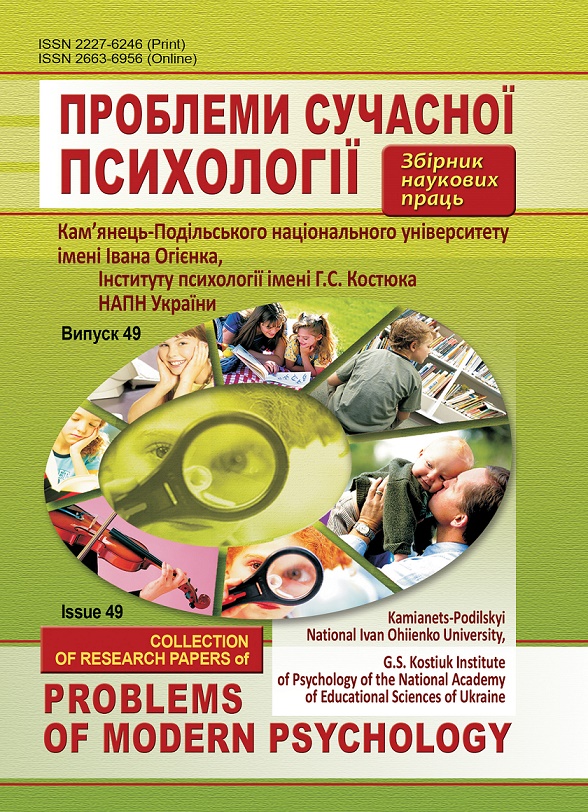Особливості соціодемографічного «портрета» осіб, які шукають шлюбного партнера в інтернет-мережі
DOI:
https://doi.org/10.32626/2227-6246.2020-49.386-406Ключові слова:
інтернет-комунікація, мовна самопрезентація осо¬бистості, аналіз анкетних даних, знайомства в Інтернеті, пошук партнера.Анотація
Мета статті – з’ясувати особливості соціодемографічного «портрета» осіб, які шукають шлюбного партнера в інтернет-мережі.
Методи дослідження. Методичний інструментарій дослідження передбачав аналіз та узагальнення праць, присвячених вивченню віртуального дискурсу осіб, які шукають шлюбного партнера в інтернет-мережі; контент-аналіз анкетних даних у контексті виявлення особливостей мовної самопрезентації користувачів, які шукають шлюбного партнера в інтернет-мережі. Збір даних для емпіричного дослідження здійснено на сайті Love.ua.
Вибірка дослідження налічувала 120 інтернет-сторінок на сайті знайомств (50 жіночих і 70 чоловічих профілів). Усі отримані емпіричні дані було проаналізовано окремо для вибірок чоловіків і жінок. Значущість різниці обраховано за допомогою φ-критерію Фішера.
Результати дослідження дали змогу визначити особливості соціодемографічного «портрета» осіб, які шукають шлюбного партнера в інтернет-мережі.
Висновок. Виявлені статеві особливості у відповідях на запитання анкети сайту знайомств відображають реальні соціально-демографічні тенденції в українському суспільстві.
З’ясовано, що для більшості чоловіків ситуація знайомства в Інтернеті є продовженням реальної життєвої ситуації, розширенням її можливостей. Жінки здебільшого звертаються до сайту знайомств як до альтернативи (компенсації) реальної життєвої ситуації. Підлітки та юнаки використовують сайт як «тренувальний майданчик», навчаючись залицянню та випробовуючи різні тактики поведінки відносно осіб протилежної статі.
Досліджено, що при створенні самопрезентації на сайті знайомств автор обмежений рамками шаблону (анкети), що регламентує комунікативну поведінку, однак йому надано відносну автономію творення власного образу. Користувачі сайту зазвичай уникають відповідей на запитання, пов’язані з їх соціальним статусом, освітою і матеріальним становищем. Проте у випадку серйозного ставлення до знайомства ця інформація є необхідною, адже вона стосується схожості соціального базису майбутніх партнерів.
Посилання
Бугайова Н. М. Віртуальні романтичні стосунки в інтернеті, кіберсексу¬альна залежність. URL : http://newlearning.org.ua/sites/default/ files/praci/zbirnyk-2008/3.htm.
Державна служба статистики України. Статистика шлюбного віку жінок та чоловіків по Україні в період з 1990–2018 роки URL : https:// dostup.pravda.com.ua/request/statistika_shliubiv_ta_rozluchie.
Мацюк В. В. Психологічні механізми формування у молоді образу майбутнього шлюбного партнера: автореф. дис. …. канд. психол. наук: 19.00.07. Київ, 2019. 21 с.
Митина О. В., Войскунский А. Е. Интернет в гендерном измерении. Введение в гендерные исследования / под общ. ред. И. В. Костико¬вой. Москва : Аспект-Пресс, 2015. С. 204–216.
Ухова Л. В. Социокультурный «портрет» потребителя брачной рекламы. Ярославский педагогический вестник. 2014. № 4. URL : https:// cyberleninka.ru/article/n/sotsiokulturnyy-portret-potrebitelya-brachnoy-reklamy.
Чернобровкина И. Г. Гендерные аспекты в анализе интернет-коммуни¬каций. Интегративный поход к психологии человека и социаль¬ному взаимодействию людей: Материалы Х Всероссийской науч¬но-практической конференции. Москва : СВИВТ, 2018. С. 155– 162.
Шебанова В., Тавровецька Н. Застосування інструментарію візуаль¬но-наративного підходу у психологічній допомозі особистості. Психолінгвістика. 2018. Вип. 24 (1). С. 381–402. URL : https:// doi.org/10.31470/2309-1797-2018-24-1-381-402.
Шебанова В., Яблонська Т., Нікнейм як засіб мовної самопрезента¬ції в Інтернеті осіб з порушеннями харчової поведінки. Психо¬лінгвістика. 2019. Вип. 25 (1). С. 409–430. URL : https://doi. org/10.31470/2309-1797-2019-25-1-409-430.
Шнейдер Л. Б. Психология семейных отношений. Москва : ЭКСМО- Пресс, 2018. 512 с.
Lea, M., & Spears, R. (2017). Paralanguage and social perception in com¬puter-mediated communication. Journal of Organizational Computing, 4, 321–341.
Suler, J. (2018). The Basic Psychological Features of Cyberspace Elements of a Cyberpsychology Model. The Psychology of Cyberspace, 8. URL : http://users.rider.edu/~suler/psycyber/psycyber.html.
Vasalou, A., & Joinson, A. (2019). Me, myself and I: The role of interac¬tional context on self-presentation through avatars. Computers in Human Behavior, 25, 510–520.
##submission.downloads##
Опубліковано
Як цитувати
Номер
Розділ
Ліцензія
Редакція має повне право публікувати у Збірнику оригінальні наукові статті як результати теоретичних і експериментальних досліджень, які не знаходяться на розгляді для опублікування в інших виданнях. Автор передає редколегії Збірника права на розповсюдження електронної версії статті, а також електронної версії англомовного перекладу статті (для статей українською та російською мовою) через будь-які електронні засоби (розміщення на офіційному web-сайті Збірника, в електронних базах даних, репозитаріях та ін).
Автор публікації зберігає за собою право без узгодження з редколегією та засновниками використовувати матеріали статті: а) частково чи повністю в освітніх цілях; б) для написання власних дисертацій; в) для підготовки абстрактів, доповідей конференцій та презентацій.
Автор публікації має право розміщувати електронні копії статті (у тому числі кінцеву електронну версію, завантажену з офіційного web-сайту Збірника) на:
- персональних web-ресурсах усіх Авторів (web-сайти, web-сторінки, блоги тощо);
- web-ресурсах установ, де працюють Автори (включно з електронними інституційними репозитаріями);
- некомерційних web-ресурсах відкритого доступу (наприклад, arXiv.org).
Але в усіх випадках обов’язковою є наявність бібліографічного посилання на статтю або гіперпосилання на її електронну копію, що містяться на офіційному сайті Збірника.






